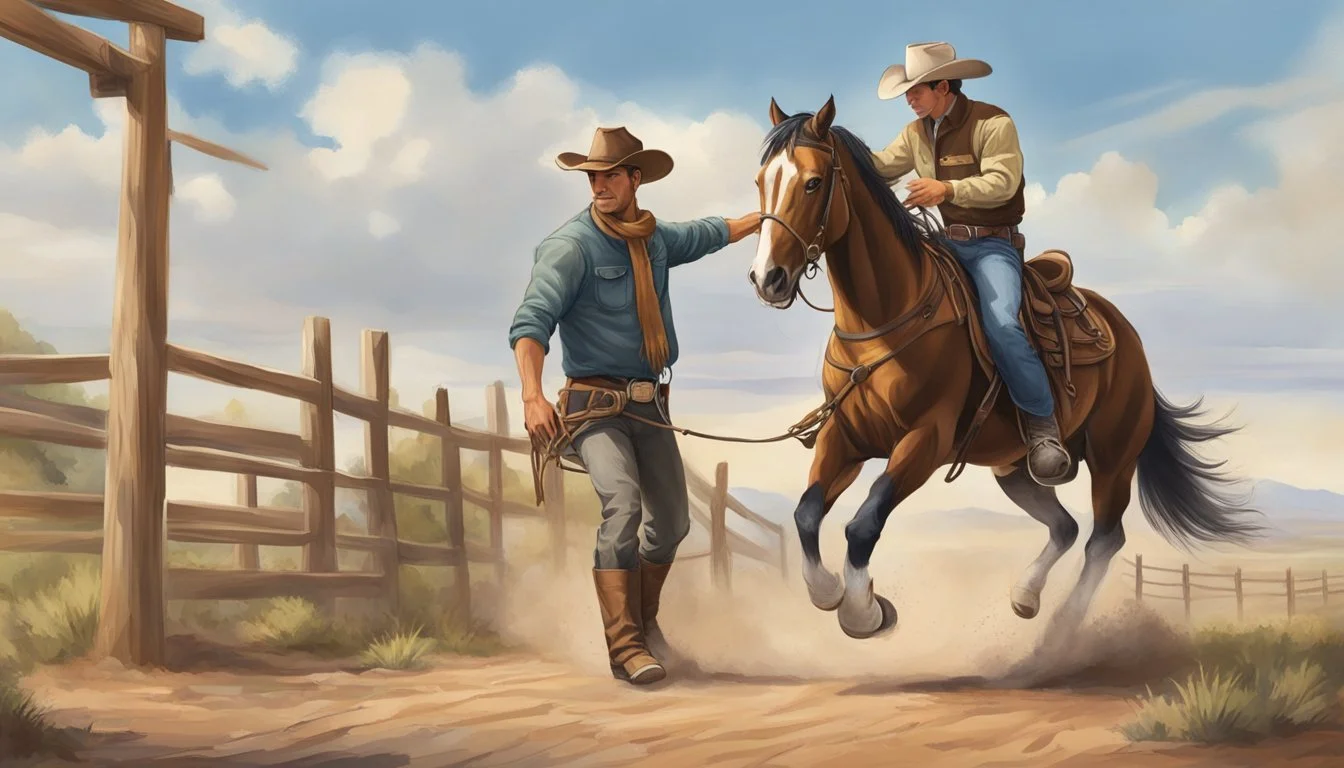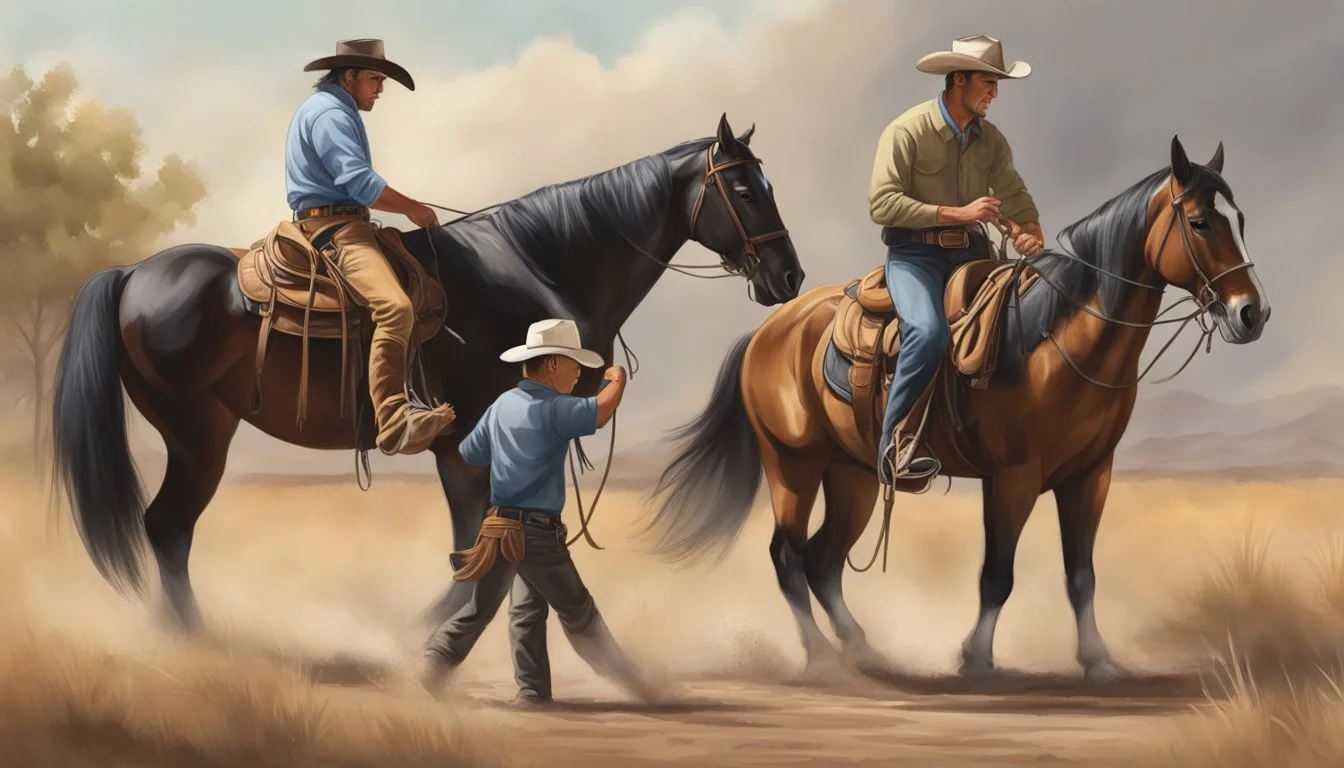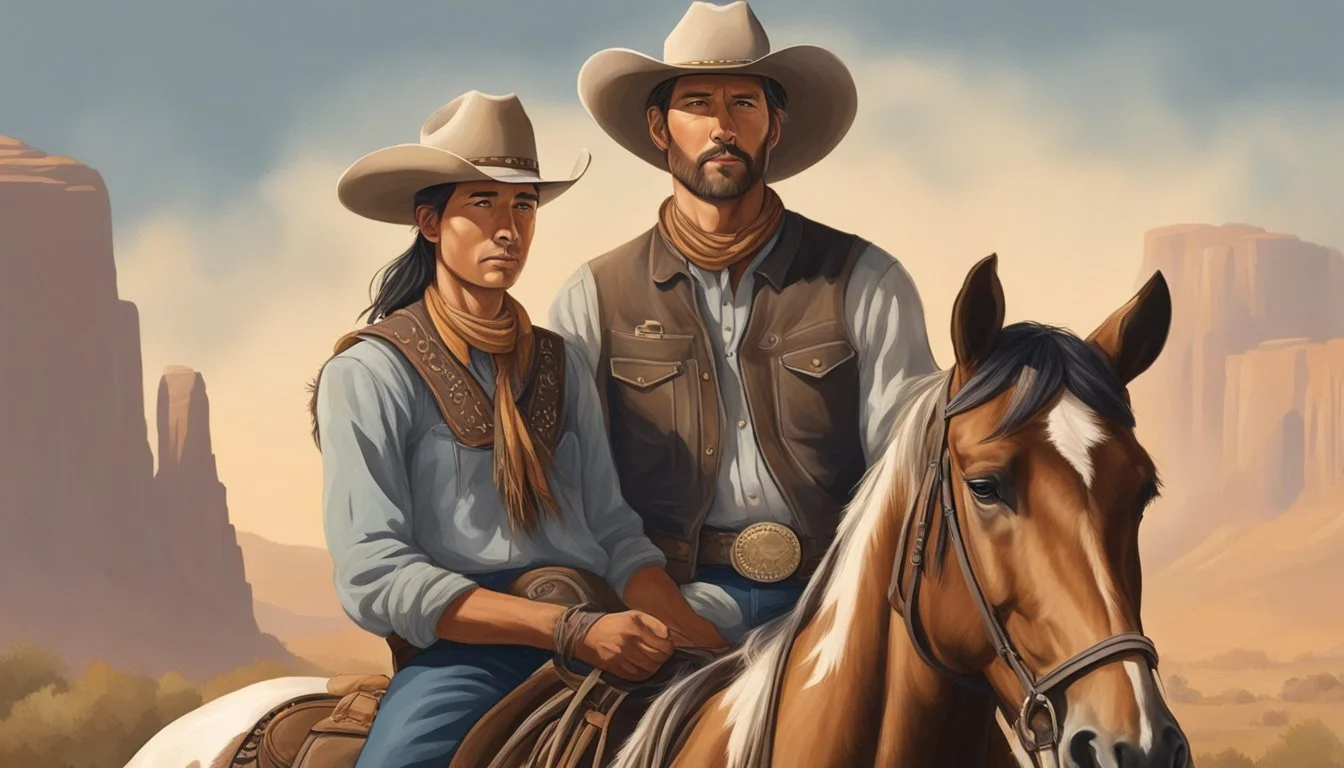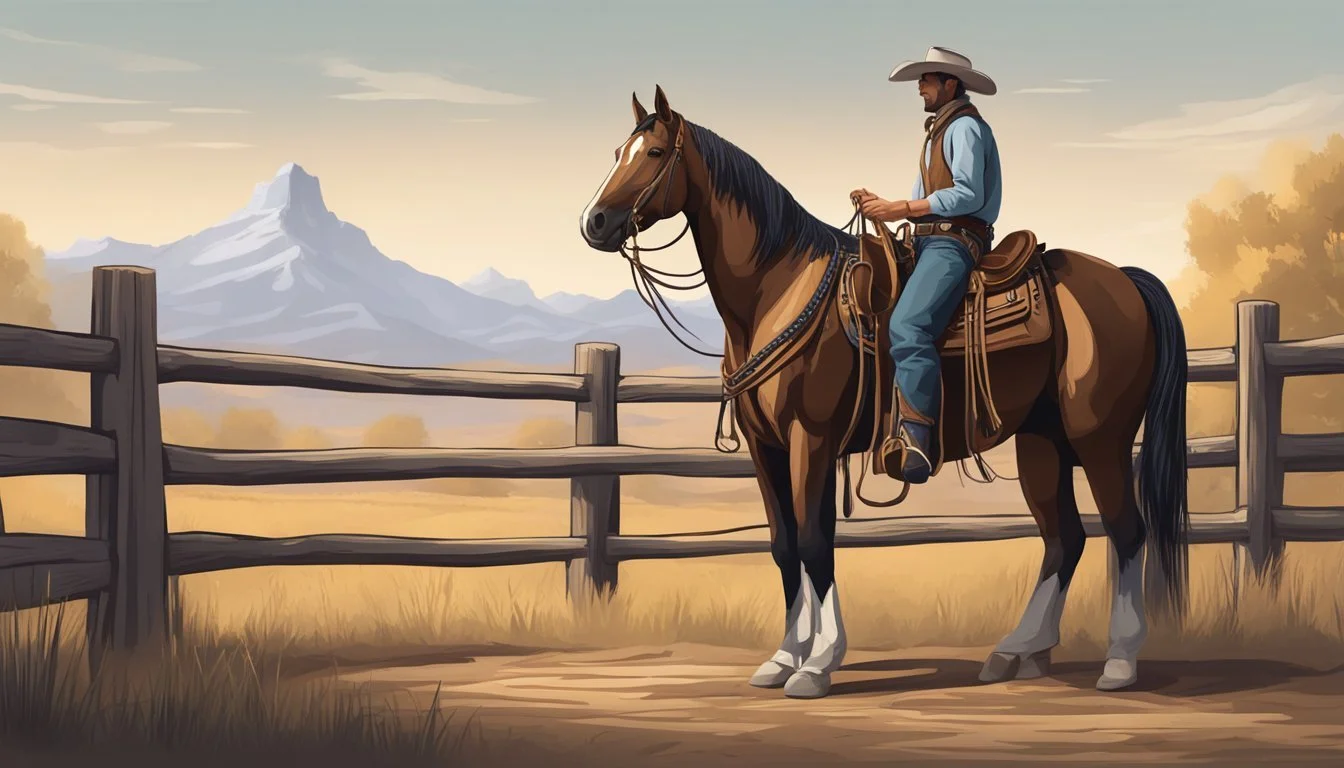The Techniques for Training a Cowboy's Best Friend
Effective Equine Training Strategies
Training a horse requires patience, dedication, and a deep understanding of equine behavior. For the cowboy, whose day-to-day activities rely heavily on a dependable and well-trained horse, these skills are not just beneficial, they are critical to the successful handling of their equine partners. Techniques in training a western show horse, for instance, revolve around creating clear communication and control, which enable horse and rider to work in seamless harmony.
Central to cowboy horsemanship is mastering the basics of riding and handling. Approaching a horse with calm confidence, knowing the proper way to position oneself when mounting, and establishing a gentle yet firm grip on the reins all contribute to the foundation of a safe and responsive riding experience. A well-trained horse is not only beneficial for tasks such as cattle herding but also for competitive disciplines like Cowboy Dressage, where the smooth flow of communication between horse and rider is both the method and the goal of training.
Pole bending training and Cowboy Dressage are exemplary of the precise yet relaxed atmosphere that characterizes western riding techniques. These methods focus not on the machinery of discipline - the proper headset or specific breed of horse - but rather on the quality of interaction and responsiveness that results in balanced, light, and comfortable rides. The training exercises and tests used in these disciplines aim to enhance the natural gaits of the horse while maintaining the integrity and heritage of the western riding style.
History and Origins of the Cowboy-Horse Bond
The bond between cowboys and horses extends back to the periods of early horse domestication and is epitomized by the vaquero tradition, which profoundly influenced cowboy culture in regions such as Texas and Montana.
The Vaquero Tradition
The vaquero, a term originating from Spanish influence, is the predecessor of the North American cowboy. This tradition started in the Iberian Peninsula and, through the Spanish conquest, was transplanted to the Americas. The methods espoused by the vaqueros for training horses in Mexico were advanced and later adapted by cowboys, particularly in Texas. They focused on fostering a partnership that emphasized softness, rhythm, and mutual respect between the equus and rider, leading to techniques that allowed for the precise and responsive handling of cattle.
Horse Domestication and Role in Cowboy Life
The domestication of horses revolutionized transportation and labor in many societies, and this was certainly the case for what became the cowboy way of life in the United States. Once brought across by Spanish explorers, equines became integral to the management of cattle and traversing the expansive terrains of places like Montana. They served not only as a means of transportation but also as a working partner in herding and ranch activities, essential to the daily tasks and success of the cowboy. The development of horse breeds suited to these tasks paralleled the evolution of the cowboy's expertise in managing and training these pivotal partners.
Fundamentals of Equine Psychology
In training horses, understanding their mental processes and social behaviors is crucial for effective communication and trust-building. These equine psychology fundamentals lay the groundwork for successful horse training.
Understanding Horse Behavior
Horses, as prey animals, exhibit behaviors stemming from their need for safety and survival. Recognizing this inherent trait is the first step toward establishing a solid training regimen. Each horse may express stress or discomfort through facial expressions or changes in body language, underscoring the necessity of attentive observation. Trainers must learn to communicate with horses on their terms, interpreting these subtle cues to gain insight into their mental state. A calm and reassuring approach establishes trust, while consistent responses reinforce respect, pivotal aspects in the human-horse relationship.
The Social Dynamics of Horses
Horses are inherently social creatures, thriving in environments that replicate their natural herd structure. They communicate with each other through a complex system of non-verbal signals, including ear positions, tail swishing, and body posturing. Understanding these social interactions is key; it allows trainers to integrate themselves effectively into the horse's social hierarchy. Mimicking these communication signals can help in forming stronger connections. The goal is to position oneself as a benevolent leader to whom a horse looks for direction and reassurance amidst the herd's dynamics.
Preparing for Training
Prior to initiating the training process, it is critical to select a horse that aligns with the rider's skill level and to gather the necessary equipment. These foundational steps ensure a smoother and more effective training experience.
Selecting the Right Horse
When choosing a horse for training, one must consider the animal’s disposition and physical attributes. A horse that is calm and willing to learn is ideal for training, especially for novice trainers. Size also plays a pivotal role; the horse should be of adequate size and strength to perform the intended tasks.
Temperament: Opt for a horse that demonstrates patience and focus.
Physical Condition: Ensure the horse is in good health and sound, without any signs of shivering or distress.
Essential Equipment for Training
In preparation for training, the proper tack must be assembled, both for the safety of the horse and the effectiveness of the training sessions.
Saddle: Choose a saddle that fits the horse well to prevent discomfort and potential injuries. Saddles come in various types, but for cowboy-related activities, a Western saddle is typically used.
Ensure the saddle size corresponds to the horse’s build.
Bits: Selecting the correct bit is crucial for effective communication. Bits should be chosen based on the horse's level of training and individual needs.
For breaking horses, a gentler bit is often recommended to build trust.
Additional equipment like bridles, halters, and protective boots should also be gathered and adjusted to fit each individual horse before training begins.
Each item should be inspected for wear and maintained regularly to ensure both the horse's and trainer's safety during training.
Training Techniques and Methodologies
Proper training techniques are essential in cultivating a cooperative and skilled equine partner. Focusing on trust, clear communication, and skill development ensures the horse understands and responds to the demands of cowboy work, from herding to roping.
Establishing Trust and Respect
In developing trust and respect, trainers initiate gentle approaches that build confidence between the horse and handler. It is crucial that a horse perceives its trainer as a leader for which it has trust, ensuring cooperation and willingness to learn. Establishing this foundation involves consistent and patient interactions, reinforcing positive behavior and providing a safe environment.
Basic Commands and Communication
For the horse to follow basic commands, clear and consistent communication is required. This begins with fundamental cues that teach the horse to:
Move forward: applying light pressure with the legs.
Stop: pulling softly on the reins and sitting deep in the saddle.
Turn: using leg pressures and rein signals.
Each command is reinforced through repetition until the horse responds with minimal prompting, reflecting a solid understanding of human cues.
Advanced Training for Roping and Riding
Moving beyond basics, advanced training equips the horse for specific cowboy tasks like roping and riding through rough terrain. This phase includes:
Desensitization to ropes and sudden movements.
Practice with dummies before live herd work.
Sharp turns and stops for cutting and herding cattle.
Ropers require horses that are not only responsive but can also anticipate a cowboy’s next move, showcasing the epitome of refined horsemanship.
Practical Applications on the Ranch
In the life of a ranch, horses are indispensable partners for cowboys. Their training is geared towards specific tasks that facilitate the daily operations of a working ranch, from cattle herding to navigating challenging terrains.
Cattle Herding Fundamentals
Herd management begins with a well-trained horse, a cowboy's trusted ally in moving and controlling cattle. Communication between cowboy and horse is vital; subtle cues and commands dictate the herding process. They operate on a principle where horses learn to mirror the movements of cattle, positioning themselves to guide the herd effectively.
Cutting: Separating a cow from the herd requires a horse to be agile and responsive.
Driving: Moving cattle from one location to another, horses maintain a steady pace and direction.
Training sessions replicate these scenarios to instill a sense of familiarity and purpose in the horse, ensuring they respond appropriately during actual herding operations.
Managing Livestock in Rough Country
Ranchers often face the challenge of managing livestock across varied and often treacherous terrains, also known as rough country. Horses are trained to navigate these landscapes confidently while performing their duties.
Navigate obstacles: Steep inclines, water crossings, and thick underbrush.
Endurance: Long hours require horses to maintain a high level of stamina.
The emphasis is on sure-footedness, balance, and a calm disposition, which are indispensable traits for horses and cowboys working in these conditions. Training involves exposing horses to elements of rough country in a controlled manner, building their confidence and ability to move through such environments with ease.
The Role of Horses Beyond Ranch Work
Beyond their vital role in ranch work, horses play a significant part in competitive sports and recreational activities. They demonstrate remarkable versatility and aptitude beyond the ranch, highlighting the deep bonds and partnerships formed with their handlers.
Horses in Competitive Sports
Horses are integral to several competitive sports where their agility, speed, and precision are showcased. In equestrian show jumping, horses and riders work in unison to navigate a course of obstacles within a set time. The bond between horse and rider is crucial for success, as they must communicate effectively to clear each jump.
Dressage places emphasis on the horse's training and natural movements. Horses perform a series of predetermined movements known as 'tests' that display their obedience, balance, and flexibility.
In rodeo events, the colt-starting champion is a title bestowed upon a horse and rider who excel in training young horses, a testament to their skill in developing trust and refining the horse's talents for the competitive arena.
Recreational Riding and Bonding
Recreational riding offers an opportunity for riders to form lasting partnerships with their horses. These activities emphasize the story of the horse, the journey from a young colt to a trusted companion. Leisure rides through various terrains allow the horse and rider to strengthen their bond and enjoy the simplicity of a ride for pleasure.
Trail riding, in particular, allows horse and rider to explore new environments, fostering a sense of adventure and trust. This casual atmosphere supports the growth of mutual respect and understanding, enhancing the bonds that carry over to more structured settings.
Caring for the Cowboy’s Partner
In the realm of ranching and rodeo, the horse is not merely a tool but a vital companion. The health and well-being of these equine partners are paramount to the success and efficiency of any cowboy’s tasks.
Nutrition and Health
Proper nutrition is the cornerstone of a horse’s health. A balance of forage, grains, and supplements must be tailored to the individual needs of the horse, considering its age, weight, and workload. Cowboys often rely on a mix of high-quality hay, pasture grazing, and specially formulated feeds to keep their horses in top condition. Access to clean, fresh water and a mineral-rich salt lick is essential for maintaining hydration and electrolyte balance.
The horse’s health should be monitored regularly, with vaccinations and deworming schedules upheld diligently. Prompt attention to any signs of illness or injury is crucial. Resources are typically set aside for veterinary care, ensuring that the horse receives professional medical attention when needed.
Vaccination Schedule:
Spring: Equine Influenza, Tetanus, Eastern/Western Encephalomyelitis
Fall: West Nile Virus, Rabies
Deworming: Every 3-6 months, depending on the specific needs and environment
Regular Grooming and Maintenance
Grooming is not only about cleanliness but also about fortifying the bond between the horse and human. Daily brushing helps to remove dirt, debris, and loose hair, while also allowing the cowboy to inspect the horse’s skin for any issues such as cuts or irritations. Hoof care, including regular cleaning and trimming or shoeing by a farrier, is vital to prevent lameness and other hoof-related problems.
Cowboys ensure that tack—saddles, bridles, halters—is cleaned and inspected for wear and tear before and after every ride, preventing discomfort and potential injuries to the horse. This maintenance regime promotes a comfortable and safe environment, enhancing the partnership and performance of horse and rider.
Hoof Care:
Daily: Picking out hooves
Every 6-8 weeks: Trimming/shoeing
Tack Maintenance:
After every use: Wipe down to remove sweat and dirt
Monthly: Deep clean and condition leather
By steadfastly caring for a horse's nutritional needs, health, grooming, and maintenance, the cowboy ensures the longevity and happiness of their sage equine companion.
Cultural Impact and Preservation
The cultural bond between cowboys and their horses has ingrained itself into the media and initiatives that aim to conserve these traditions play a crucial role in maintaining this heritage.
The Cowboy and Horse in Media
Over the years, the cowboy and his horse have become iconic symbols in various forms of media. Movies, such as classic Westerns, have portrayed this relationship as the embodiment of freedom and resilience, central to the narrative of American folklore. Television shows and rodeos often showcase the equestrian skills that define cowboy life, reflecting their enduring appeal.
In literature, cowboys are often depicted astride their horses, tackling the challenges of nature and cattle rearing. This portrayal has been instrumental in romanticizing the cowboy and vaquero image and giving audiences a glimpse into the roots of cowboy culture in places like Colorado and the broader American West.
Conservation of Cowboy and Equine Traditions
Efforts to preserve cowboy and equine traditions have taken various forms.
Museums and heritage sites: They offer a window into cowboy life. Artifacts, including saddles, lariats, and branding irons, offer tangible connections to the past.
Cultural festivals and rodeos: Events such as the Colorado State Fair celebrate the techniques and heritage of cowboy and vaquero culture, showcasing the skills that are central to the handling and training of horses.
Educational Programs: They teach the public about the nature of things within cowboy life, from horsemanship to the environmental stewardship cowboys must maintain.
Historical Preservations: Non-profit organizations work to conserve lands and traditions associated with the cowboy legacy.
Through these mediums and initiatives, the spirit of the cowboy and their equine counterparts continue to resonate within society.
Addressing Common Challenges
Training horses requires a delicate balance of communication, trust, and respect. Addressing behavioral issues promptly and considering retirement needs are pivotal for maintaining a healthy rapport between a cowboy and their equine companion.
Behavioral Issues and Troubleshooting
Behavioral challenges when training horses can often be attributed to communication breakdowns or a lack of trust. Horse trainers must identify the root causes of behaviors such as bucking or refusal to follow commands. It's essential to build a relationship based on respect to effectively troubleshoot these issues. For instance, a two-year-old colt from Kansas may display stubbornness due to inexperienced handling. In such cases, trainers might:
Establish clear communication: Use consistent commands to avoid confusion.
Trust development: Spend more time with the horse to develop a deeper bond.
Methods to overcome behavioral challenges include:
Positive reinforcement: Reward desired behaviors to encourage repetition.
Corrective actions: Gently correct unwanted behaviors immediately when they occur.
The Aging Horse and Retirement Considerations
An aging horse faces a different set of challenges, such as decreased stamina and health issues. Trainers must adjust routines accordingly. For example, a senior horse may require:
Reduced intensity: Lighter exercises to match the horse's lower energy levels.
Health management: Regular check-ups with a veterinarian to monitor any developing conditions.
When considering retirement for an aging horse, one must assess:
Quality of life: Ensure the horse maintains a good quality of life even after retirement from active work.
Appropriate care: Provide suitable accommodations and care tailored to the horse's changing needs.
Evaluating if a horse is ready for retirement depends on various factors, including its physical condition and ability to perform.ilon
Resources and Further Learning
To excel in cowboy horsemanship, one must seek comprehensive resources and connect with expert organizations. These tools and connections provide the foundational knowledge and communal support necessary for mastering the art of horse training.
Literature and Studies on Horsemanship
A plethora of literature exists for those looking to deepen their understanding of horse training techniques specific to cowboys. Books such as "The Modern Art of Taming Wild Horses" by J.S. Rarey and periodicals like Western Horseman offer historical insights and contemporary advice. Scholars and enthusiasts alike can access studies through databases such as JSTOR or ScienceDirect which often publish peer-reviewed articles on equine behavior and training methods.
Key Literature:
"The Modern Art of Taming Wild Horses" - J.S. Rarey
Western Horseman Magazine
Research Databases:
JSTOR
ScienceDirect
Community and Professional Organizations
Professional organizations are pivotal in the journey of a cowboy's horsemanship skills development. Groups such as the National Cowboy & Western Heritage Museum not only preserve cowboy history but also offer resources and events to educate on proper horse care and training. Similarly, organizations like American Quarter Horse Association (AQHA) and local ranching associations provide workshops, networking opportunities, and competitive events that promote the standards of excellence in horsemanship.
Organizations:
National Cowboy & Western Heritage Museum
American Quarter Horse Association (AQHA)
Local Ranching Associations
Conclusion
Training a horse for the varied tasks a cowboy needs requires a blend of traditional techniques and understanding the horse's natural instincts. Various methods exist, influenced by practical necessities, such as the "cowboy started" approach, which aims to quickly prepare a horse for a range of situations. This technique, while not suited for all modern equestrian needs, has proven effective in creating versatile and reliable mounts for ranch work.
Natural horsemanship is another vital training approach, focused on communication that aligns with the horse's instincts. It emphasizes a respectful and partnership-based interaction where the horse learns to choose correct behaviors without feeling compelled to submit.
When training horses for specific tasks like mounted shooting, acclimating them to startling stimuli is essential. A gradual introduction to the sound of gunfire, paired with consistent reassurance, can help a horse remain calm during such activities.
For racehorses, foundational training—akin to a basic school—is crucial. It establishes the groundwork of racing, including obedience and muscle development. As the horse progresses, advanced techniques fine-tune their skills and optimize performance.
It's imperative to remember that patience, consistency, and a deep understanding of equine behavior are the cornerstones of effective horse training, regardless of the method chosen. Trainers who apply these principles can develop a trustworthy and skilled companion for the cowboy's demanding work.








